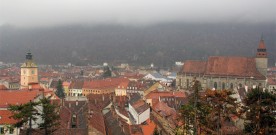I had it penciled into my itinerary, but a looming snow forecast and a lack of proper winter weather gear had me second guessing traveling from Bucharest to Brasov by 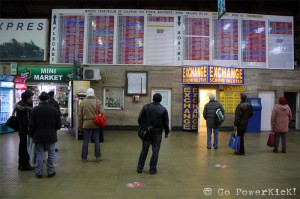 train. Helping sway my decision to make the trek was Talon, who was currently living in Brasov and who had offered to show me around the city.
train. Helping sway my decision to make the trek was Talon, who was currently living in Brasov and who had offered to show me around the city.
Checking the train schedule online it showed the ride covered around 170 km and took about 2 hours and 40 minutes. Fortunately, trains left pretty much every hour from the Bucharest North station making the arrival in Brasov relatively easy.
I wanted to arrive in Brasov as early as possible to leave ample time for sightseeing, so I booked a ticket on the 7am InterRegio(IR) train the night before at the station, for a round trip cost of 101 RON ($31.12), which got me into Brasov at 9:41am.
I arrived at the station around 6:30am, got a pretzel for breakfast and located the track where my train was leaving from. The morning was colder than usual and when I boarded the t rain I was pleasantly surprised upon walking in. The seats were wide, comfortable and the train compartment was nice and warm compared to the slightly above freezing temperatures outside.
rain I was pleasantly surprised upon walking in. The seats were wide, comfortable and the train compartment was nice and warm compared to the slightly above freezing temperatures outside.
Heading out of Bucharest the combination of country scenery zooming past and a toasty train compartment helped lull me to sleep rather quickly. I woke up just before arrival in Brasov to an icy sky, the color of steel, dropping large snowflakes that were blanketing the beautiful mountain scenery outside the window. As this was the first time I’d seen snow in about 6 years I was pretty excited, however, I knew this meant our tour through Brasov would be a cold one.
Once in Brasov I hopped on the #4 bus in front of the train station and rode it to the Livada Postei stop right in the 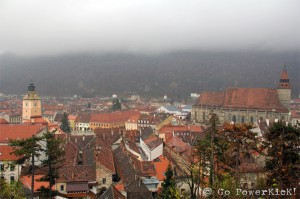 heart of town. I met up with Talon and we began our walk through one of Romania’s most visited cities.
heart of town. I met up with Talon and we began our walk through one of Romania’s most visited cities.
Imparting the knowledge he’d learned from his time thus far in Brasov, I learned the city was first settled by the Saxon’s around the 1100’s, and ever since calling Brasov home they’d been fending off invaders. After many attempts by the Mongols and Turks to conquer Brasov, the Saxons ended up building tall walls around the city to fortify their home.
Our walk started around the exterior of the walled city and our first stop was the White Tower. Serving as a lookout point, we climbed up the 200 plus steps to the top to see the fantastic view of the city’s gothic and renaissance architecture below. Adding to the excitement of the medieval ambiance was the falling snow. Although I was unable to see the large Brasov 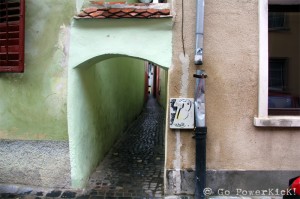 sign on the hill behind the city, watching the snow fall was like seeing something straight out of a movie.
sign on the hill behind the city, watching the snow fall was like seeing something straight out of a movie.
Our stroll weaved through the city and led us down Europe’s narrowest street, Strada Sforii. Named The Rope Street, it’s roughly 3 to 4 feet wide and was apparently initially used by the city’s firefighters. Twisting back into the town center we entered The Council Square, a large open area lined with shops which is a great place to people watch and enjoy the scenery.
Peeking out above the roofline at the far end the square is Brasov’s most famous attraction, the Black Church. The church is the largest gothic church in Romania and got its name from the damage it sustained during the Great Fire of 1689, which left its walls with a permanent blackened residue. Inside, the high ceilings, stained glass windows and enormous organ help give the church’s gothic interior both an elegant and elaborate feeling.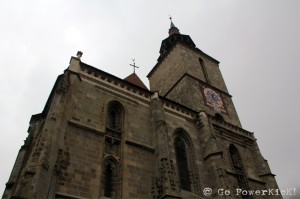
We ended the day with a hearty meal of traditional Romanian sarmale, cured meat and Transylvania soups at the Restaurant Sergiana. All in all, although the weather was cold, the train ride from Bucharest to Brasov and back was quite an easy one and the walking tour with Talon was of professional tour guide quality. If you’re planning a trip to Romania I definitely suggest adding Brasov to your itinerary; and perhaps staying an extra day to visit Dracula’s castle.
Comments
More Good Reads!

The Best Mai Tai In The World
May 23, 2014
Helicopter Over Oahu
May 10, 2014
May 2014 PowerKicK Of The Month
May 01, 2014
Bike The Golden Gate Bridge
April 29, 2014
Hua Hin Hills Vineyard
April 19, 2014
Songkran in Nan
April 10, 2014
April 2014 PowerKicK Of The Month
April 01, 2014
Mae Hong Son Motorcycle Loop: Mae Sot to Mae Hong Son
March 28, 2014
Becoming A Buddhist Monk In Thailand
March 20, 2014






